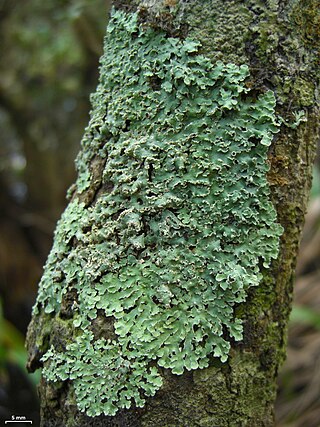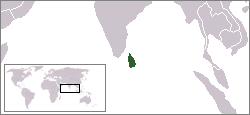
Usnic acid is a naturally occurring dibenzofuran derivative found in several lichen species with the formula C18H16O7. It was first isolated by German scientist W. Knop in 1844 and first synthesized between 1933 and 1937 by Curd and Robertson. Usnic acid was identified in many genera of lichens including Usnea, Cladonia, Hypotrachyna, Lecanora, Ramalina, Evernia, Parmelia and Alectoria. Although it is generally believed that usnic acid is exclusively restricted to lichens, in a few unconfirmed isolated cases the compound was found in kombucha tea and non-lichenized ascomycetes.

Physcia is a genus of lichen-forming fungi in the family Physciaceae. The widely distributed genus contains about 80 species. The genus is cosmopolitan, and has been extensively studied in various regions in the past several decades, with significant biodiversity in South America identified as a central diversity hotspot. Physcia species are foliose, lobate lichens that grow with a loose to close appressed habit. Their upper surface is typically whitish, pale greenish, green-grey, or dark grey in colour. The thallus colour remains relatively unchanged when moistened. Physcia lichens typically grow on bark, on wood, or rock, although they have occasionally been recorded dwelling on man-made structures. They thrive in nutrient-rich environments and are expanding rapidly in urban areas of the United Kingdom previously affected by SO2 pollution.

André Aptroot is a Dutch mycologist and lichenologist. His primary research focus is on biodiversity, particularly tropical lichens, encompassing systematics, floristic surveys, and taxonomic reviews. A prolific researcher, he has published more than 500 scientific papers and described hundreds of new fungal and lichen species.
Syo Kurokawa was a renowned Japanese lichenologist and 1994 recipient of the Acharius Medal. He studied under Mason Hale and Yasuhiko Asahina.

Carolyn Wilson Harris was vice president of the Sullivant Moss Society during 1904–1905 and charge of the Lichen Department from 1901 to 1905. She also wrote many articles on various lichen genera and species. She was known for being an indefatigable worker, and did much to popularize the study of lichens; her help was always given freely and cheerfully to those who applied to her for assistance in their studies.

Malmidea is a genus of crustose lichens and the type genus of the family Malmideaceae. It was established in 2011 to contain a phylogenetically distinct group of species formerly placed in the genus Malcolmiella. The crust-like thallus of Malmidea lichens has a surface that varies from smooth to rough, featuring textures such as verrucose (wart-like), granulose (grainy), or pustulate (pimpled). These textures are often formed by goniocysts, which are spherical clusters of green algal cells from the family Chlorococcaceae, encased in fungal hyphae. Malmidea comprises nearly 70 mostly tropical species that grow on bark, although a few grow on leaves.
Thomas Hawkes Nash III is an American lichenologist. His research is about the biology and ecology of lichens, and the effects of air pollution on plants and lichens. He is known as an authority on the family Parmeliaceae. During his long career at the Arizona State University, he helped develop the lichen herbarium into a world-class collection with over 100,000 specimens representing more than 5000 species. In 2010, the year of his retirement, he was awarded the Acharius Medal for lifetime achievements in lichenology, and the following year had a Festschrift published in his honor.
Klaus Kalb is a German lichenologist and an authority on tropical lichens. Born in Nuremberg, he studied at the University of Erlangen–Nuremberg before pursuing a career that significantly advanced the field of lichenology, particularly in Brazil. Kalb's work in São Paulo from 1978 to 1981 led to a collaboration with Brazilian lichenologist Marcelo Pinto Marcelli, which is considered a model for non-commercial benefit-sharing in taxonomic research. He later became an associate professor at the University of Regensburg and is known for editing the exsiccata series Lichenes Neotropici. Kalb's contributions to lichenology include over 120 scientific publications, the description of numerous new species, and the development of a substantial lichen collection. His work has been recognised through various honours, including four lichen genera and numerous species named after him, as well as a Festschrift published in 2007 to mark his retirement.

Lichexanthone is an organic compound in the structural class of chemicals known as xanthones. Lichexanthone was first isolated and identified by Japanese chemists from a species of leafy lichen in the 1940s. The compound is known to occur in many lichens, and it is important in the taxonomy of species in several genera, such as Pertusaria and Pyxine. More than a dozen lichen species have a variation of the word lichexanthone incorporated as part of their binomial name. The presence of lichexanthone in lichens causes them to fluoresce a greenish-yellow colour under long-wavelength UV light; this feature is used to help identify some species. Lichexanthone is also found in several plants, and some species of fungi that do not form lichens.
Henricus (Harrie) Johannes Maria Sipman is a retired Dutch lichenologist who specialised in tropical and subtropical lichens and authored or co-authored over 250 scientific publications. He was the curator of the lichen herbarium at the Berlin Botanical Garden and Botanical Museum from 1983 until his retirement in 2010. Between 1990 and 1997 he edited and distributed the exsiccata Lichenotheca Latinoamericana a museo botanico Berolinensi edita.

Bacidina pycnidiata is a species of crustose lichen in the family Ramalinaceae. It is widely distributed in Europe and North Asia. It is characterised by its whitish or cream-coloured pycnidia with long and ostiolar necks.

The following outline provides an overview of and topical guide to lichens.









